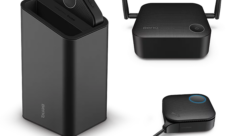Lanning And Designing Your Vtdeo Room: Our take on the best plan for theultimate home viewing experience
Feb 1, 1998 12:00 PM
‘There is very little that can compare to the feeling and excitement of—attending a live event – albeit a music concert, boxing match orbaseball game. The experience is sensational. When discussing a hometheatre system it is agreed that a similar feeling or part of that liveexperience can be recaptured by projecting the video image onto a largescreen and reproducing the audio through a multi-channel Dolby soundsystem. By assembling the right equipment and installing it into thecorrect space one can have impressive home theatre system – for areasonable prim,
There is one golden rule in all electronics and it seldom is heard – themore your spend the better it sounds or looks ………….ego has done alot to ruin many – what could have been – wonderful media rooms. And so wetrundle through the piles of rumors, rubbish and myths to create anaffordable home system.
The first step is to choose the best space. Room dimensions are crucial forgood sound reproduction. It is always better to have a rectangular roanwith and approximate height, width and length ratio of 1.0 to 1.6 to 2.5.Since most home,. have an 81 ceiling, an appropriate media room would be13′ wide x 20′ long and if this is new construction, the walls should NOTbe parallel. YES, they should be slanted -by several degrees to help reducethe standing waves.
Sound does not emit from the front wall to the back and stop. It reflects90 degrees off the back wall, hits the floor, ceiling and side wallssimultaneously creating all kinds of reflective sound patterns and sincesound travels at 11201 per second, can create some pretty mean phase – allresulting in slight echoes and hollow sounding audio. Cancellation The’fix’ is very simple. Kick the top of the wall in about 3 or 4inches.,..”Curve the ceiling a bit. Ever notice a high dollar recordingstudio? NONE of the walls are ever parallel – and you thought they werebuilt like that to look ‘cool no, they are designed deliberately to helpreduce the standing waves and it is so simple to do. A good interiordesigner can take that and get REAL creative with matching swirls, curves,etc. in the carpets, furniture and wall coverings. Ah, yes – wall coverings…. the best wall coverings for a great sounding media room is to coverthe virgin wall board with, cotton and then cover that with a satin orother material. Creates a great look and practically eliminates ALLreflective sound patterns – and all of above for very little money.
FRONT OR REAR PROJECTIONWith the space defined, the major equipment decision will be the type andsize of the video image. The easiest – and usually least expensive will bea rear projection TV. There seems to be a glut on the market today of the 40 to 6 0 inch varieties with several late comers out to 70 and 80 inches…. however the caveat here is that many of these do not exhibit pristenevideo images. As we said earlier bigger, more expensive is NOT always thebest. There are same exquisite rear project TV items lately – but you aregoing to have to hunt for the specialty custom and industrial dealers thatcarry the likes of Hitachi’ s new SBX and the reference monitor for all tocompare – the Pioneer ELITE. These are excellent rear projection items andwould be a centerpiece to build your room around. The alternative is afront projection unit. In the past decades, the three gun analog projectorsfrom Ampro, Runco, Zenith and Sony were quite well accepted, however thereis a terrific breakthrough coming from Sharp, Ampro and others giving usLCD (liquid crystal display) projectors that are simply terrific. They arelighter, need very little service (no lens convergence) and are veryinexpensive (starting below $3,000) – all producing beautiful video imageson screen sizes up to 15 feet.
Keep in mind that any of the front projection systems not usable in highambient light so if you have lots of windows in the media room, some methodof motorized drapes or blinds will be needed to darken the room if usedduring the daylight hours. If this will be a multi-purpose room rather thana dedicated media or home theatre room, it would be advisable to look intothe 50 or 60 inch Elite rear project TV monitor instead of a projector andscreen – With e1Wr type, it is best to dedicate one wall for the screen andfront line of speakers. Two schools of thoughts about this wall. Some liketo have just the screen and speakers with no distraction from anything elsewhile many like to see the equipment racks on either side of the screen.
A very interesting approach to the design of the room is to place the 11-r-, projector BEHIND the screen. The throw distance of usually about 12feet is still needed but using a special membrane type screen that can beprojected through instead of a front projection screen that is projectedonto, can allow the projector to be moved out of sight. A great example ofthis is shown in the August issue of S & VC on page 16. Mounting aprojector BEHIND the screen can give the designer tremendous latitude, helpcut down on ambient light refractions and provide a stunning, bright imageon the screen with all focus on the picture and not the projector blaringit’s beam of light across the room.
SPEAKER PLACEMENTWe actually are dealing with science here. No questions about- that but somany of the systems seen today just seem to forget that or try to defy itand of course, it shows in the poor quality of many home theatre systems -no matter WHAT their costs. Loudspeaker placement is crucial to thefaithful reproduction of the dialog sound, the music and the specialeffects.
Front left and right speakers should beat at ear level WHEN SEATED. Nohigher. Anything less than 6′ between these two will not give a wide enoughfront spread while ten feet or greater looses the whole front image. It hasbeen proven that in the home systems with a 151 wide by 20′ long room 8 to10 feet is a perfect spread from the fronts with the center channel beingin the center with above or below the screen.
SUBWOOFERThe ideal subwoofer set up is to use two of them …. one under the left.One under the right front speakers. The subwoofer MUST be self powered witha parametric crossover so you can change the parameters for each room itoperates into. The frequency, the roll-off and the level is a must forproper subwoofers. The big caveat with all subs – if it doesn’t have abuilt in power amplifier (or dedicated amplifier just for that sub) walkaway from it. No place for toys in YOUR new home theatre!
SURROUND SPEAKERSOh, if we only could devote this entire months issue to this subject weprobably would still have things to learn about surround speakers! Firstoff – surrounds do just that – they are intended to ‘surround’ you withambience. With effects – crickets, wind blowing- effects only. You willNEVER (well maybe for a simple effect in somebody’s movie script) hear aleading role voice speaking. You will not hear a flute in the right, guitarin the left front, dialog in the center, piano in the rear, etc. IMPORTANTlisten up – Ray Dolby’s wonderful Pro Logic technology is not the old QUADsystem. It is truly a surround EFFECI channel and it is because of thisthat we must pay close attention to their placement. Science dictates here.
The ideal is to use Tom Holman’s great idea of dipole speakers so that weactually receive surround information from the reflections off the screenand rear wall. NEVER anything coming into the room directly from thesurround speakers. The best placement for in-wall or simple on the wall(picture hung type boxes) is to place them on the SIDE walls two to threefeet – NO MORE – behind the listeners ears. This creates a wonderful soundfield with the front line of speakers and enhances any 4 channel prologicsystem …. just simple and correct speaker placement.
One last item about surrounds. It has always been an industry thought thatsince Mr. Dolby only gives us 100 – 7,00OHz. in these effect rear channels,there is no low end response. Well, if you really want to enhance ANY hometheatre system – place a dedicated powered subwoofer BEHIND you connectedto, these rear surrounds. WOW! There is lots of low end response back there-enough that at the small expense ($450 – $600) for some wonderful poweredsubs, makes it a must to spec for your room.
EQUIPMENT LOCATIONLast, but certainly the most important is the equipment itself. The idealthing to do is mount it into a 19″ rack such as a Mid Atlantic rack andshelf assembly. This can be placed right into the wall or into a properlysized “hole” of your custom entertainment center. It is 70 year oldtechnology of the telephone industry and allows us to wire, test and alignall the gear then simply slide it into place. Never again having to get outthe dental mirror and loose your religion trying to get behind theequipment to plug something in! The location is your call. You like to seethe flashing L.E.D. – put it either side of the screen. Placing it behindyou will make you install some infared repeaters so you can point theremote to screen and then send that signal to the equipment behind you.
Connect AND ENJOY!Of course, once all of the hammers are at rest, the paint and glue is drywe only have to connect the wire (hopefully it was run to the correctlocations during construction) and enjoy. One small note about that wire.Another of the industry rumors is the bigger the better. Time and timeagain. Study after study has been done and a Julian Hirsch . review of 1994said it best …. the effect of the huge wires is normally only a minutechange in frequency response hardly a matter to be concerned about unlessyou are the type who agonizes about how many angels can dance on the headof a pin!!
After several thousand audio systems designed and installed, I am STILLusing 16 gauge (not the small stuff) but the large lamp cord for runs under50′ and in most of the media rooms, 50 foot runs are seldom reached. TheJBL monitors never sounded better!
Tune ‘er up and get ready to duck as Indian Jones brings the ole bi-planein for that ‘wonderful’ but noisy landing!










